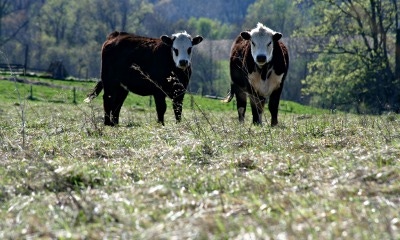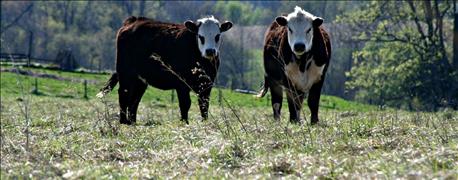November 12, 2015

Overseeding legumes into grass pastures improves livestock diets and boosts gains.
November is time to plan winter reseeding for low-cost, low-tech improved grazing on all grasses, but especially fescue.
Craig Roberts, MU Extension specialists, considers overseeding red and white clovers, plus lespedeza a paying proposition. Reseeding is easy, but an annual chore.
Roberts says clovers and lespedeza serve different roles. Red and white clovers improve nutrition of a pasture as a supplemental feed. Lespedeza fills a summer grazing gap. It becomes a second crop when summer heat brings a summer slump in grass growth.

IMPROVING PASTURES: November is time to plan winter reseeding for low-cost, low-tech improved grazing on all grasses, but especially fescue.
While legumes boost all grasses, they help most in pastures still in endophyte-infected fescue.
Legumes help all fescues
Replacing toxic K-31 fescue with a novel endophyte adds gains and other benefits. However, adding legumes to toxic fescue dilutes bad effects of ergovaline toxins.
Adding legumes to novel-endophyte fescue multiplies benefits.
For overseeding legumes Roberts combines 4 pounds of red clover and a half pound of white clover seed per acre. Lespedeza takes 7 pound for overseeding.
Red clover is a perennial plant; however with chronic crown rot in most fields it lives a two-year cycle. Also with fewer bees, common red clover has less viable seed. Annual seeding keeps red clover producing. Look for certified seed.
Once white clover becomes established and is seen in pastures annual reseeding can be let up. White clover reproduces with runners at ground level.
Annual lespedeza made its entry into Missouri, promoted by Extension, in 1930s drought years. Newer improved varieties make the legume helpful in filling dry summer slumps. Just to be clear, this is not Sericea lespedeza.
~~~PAGE_BREAK_HERE~~~
Spring overseeding became a continuing lesson from MU forage specialists. Now, they re-name the practice, calling it winter seeding. Many were applying seed later into early spring, cutting time for seedlings to mature."
"Start January 15," Roberts said. "Get out and get it done when the ground is frozen."
See overseeding on snow
"Applying on snow-covered fields allows seeing where the seeder broadcast seed," Roberts says. "We used to say: apply it on the last snow of winter. That's kind of hard to predict."
Warmer winters make early seeding more needed. Repeated thawing and refreezing helps work small seed into the ground for good soil contact for new roots.
Winter seeding catches more thaw-freeze cycles.
A caution: Seed to soil contact improves when pastures are grazed short and thatch lowered. Seed on a layer of dead plant material may germinate when moistened as temperatures rise. But, new root won't find soil. A short grass cover allows sunlight to reach seedling leaves. The sun starts photosynthesis.
Cattle can tromp thatch
Fields with thick thatch can be given a short graze with heavy stocking rate. Cattle hooves disturb the thatch, letting seeds drop to the soil. "Don't turn the cows in if temperatures are 40 degrees and the ground is soft," Roberts says. "Keep cattle on just long enough to disturb the thatch."
Plan in November to get the best seed laid in before needed in January.
Apply no nitrogen with seeding as that adds competition from old grass. The rapid growth overshadows seedlings.
You May Also Like




